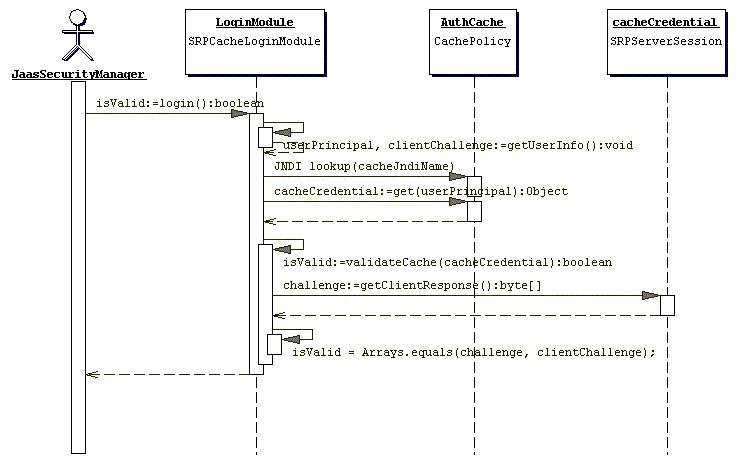The appeal of the SRP algorithm is that is allows for mutual authentication of client and server using simple text passwords without a secure communication channel. You might be wondering how this is done. If you want the complete details and theory behind the algorithm, refer to the SRP references mentioned in a note earlier. There are six steps that are performed to complete authentication:
-
The client side
SRPLoginModuleretrieves the SRPServerInterface instance for the remote authentication server from the naming service. -
The client side
SRPLoginModulenext requests the SRP parameters associated with the username attempting the login. There are a number of parameters involved in the SRP algorithm that must be chosen when the user password is first transformed into the verifier form used by the SRP algorithm. Rather than hard-coding the parameters (which could be done with minimal security risk), the JBossSX implementation allows a user to retrieve this information as part of the exchange protocol. ThegetSRPParameters(username)call retrieves the SRP parameters for the given username. -
The client side
SRPLoginModulebegins an SRP session by creating anSRPClientSessionobject using the login username, clear-text password, and SRP parameters obtained from step 2. The client then creates a random number A that will be used to build the private SRP session key. The client then initializes the server side of the SRP session by invoking theSRPServerInterface.initmethod and passes in the username and client generated random numberA. The server returns its own random numberB. This step corresponds to the exchange of public keys. -
The client side
SRPLoginModuleobtains the private SRP session key that has been generated as a result of the previous messages exchanges. This is saved as a private credential in the loginSubject. The server challenge responseM2from step 4 is verified by invoking theSRPClientSession.verifymethod. If this succeeds, mutual authentication of the client to server, and server to client have been completed. The client sideSRPLoginModulenext creates a challengeM1to the server by invokingSRPClientSession.responsemethod passing the server random numberBas an argument. This challenge is sent to the server via theSRPServerInterface.verifymethod and server's response is saved asM2. This step corresponds to an exchange of challenges. At this point the server has verified that the user is who they say they are. -
The client side
SRPLoginModulesaves the login username andM1challenge into theLoginModulesharedState map. This is used as the Principal name and credentials by the standard JBossClientLoginModule. TheM1challenge is used in place of the password as proof of identity on any method invocations on J2EE components. TheM1challenge is a cryptographically strong hash associated with the SRP session. Its interception via a third partly cannot be used to obtain the user's password. -
At the end of this authentication protocol, the SRPServerSession has been placed into the SRPService authentication cache for subsequent use by the
SRPCacheLoginModule.
Although SRP has many interesting properties, it is still an evolving component in the JBossSX framework and has some limitations of which you should be aware. Issues of note include the following:
-
Because of how JBoss detaches the method transport protocol from the component container where authentication is performed, an unauthorized user could snoop the SRP
M1challenge and effectively use the challenge to make requests as the associated username. Custom interceptors that encrypt the challenge using the SRP session key can be used to prevent this issue. -
The SRPService maintains a cache of SRP sessions that time out after a configurable period. Once they time out, any subsequent J2EE component access will fail because there is currently no mechanism for transparently renegotiating the SRP authentication credentials. You must either set the authentication cache timeout very long (up to 2,147,483,647 seconds, or approximately 68 years), or handle re-authentication in your code on failure.
-
By default there can only be one SRP session for a given username. Because the negotiated SRP session produces a private session key that can be used for encryption/decryption between the client and server, the session is effectively a stateful one. JBoss supports for multiple SRP sessions per user, but you cannot encrypt data with one session key and then decrypt it with another.
To use end-to-end SRP authentication for J2EE component calls, you need to configure the security domain under which the components are secured to use the org.jboss.security.srp.jaas.SRPCacheLoginModule. The SRPCacheLoginModule has a single configuration option named cacheJndiName that sets the JNDI location of the SRP authentication CachePolicy instance. This must correspond to the AuthenticationCacheJndiName attribute value of the SRPService MBean. The SRPCacheLoginModule authenticates user credentials by obtaining the client challenge from the SRPServerSession object in the authentication cache and comparing this to the challenge passed as the user credentials. Figure 8.15, “A sequence diagram illustrating the interaction of the SRPCacheLoginModule with the SRP session cache.” illustrates the operation of the SRPCacheLoginModule.login method implementation.

Figure 8.15. A sequence diagram illustrating the interaction of the SRPCacheLoginModule with the SRP session cache.